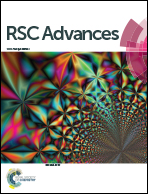A facile Al(iii)-specific fluorescence probe and its application in biological systems†
Abstract
A facile fluorescence receptor was easily synthesized by an one-step reaction of 3,4-dihydroxybenzaldehyde and hydrazinecarbothioamide. The receptor as a fluorescence probe was used to recognize metal ions by UV-vis and fluorescence techniques. The data of UV-vis and fluorescence spectra display the high sensitivity and selectivity of the receptor for Al(III) ions. When introducing Al(III) ions, the fluorescence of the probe exhibits an obvious enhancement because of inhibiting the photoinduced electron transfer (PET) process. The certain bonding mode of the receptor with Al(III) was verified by 1H NMR, HRMS-ESI and Job-plot data. The prospective fluorescence “Off–On” signal for Al(III) ions including the color change of the receptor solution was observed. The detection limit of the receptor for Al(III) may reach 10−7 mol L−1. Noticeably, the probe as a fluorescence “Off–On” switch can detect the trace level of Al(III) in living cells and mouse organs. The work provides a strategy for design simple fluorescence probes for Al(III) and applications in biological systems.


 Please wait while we load your content...
Please wait while we load your content...